Nonconstruction business was mixed last year. Materials producers did better than expected; mining and energy continued their downward trend; and utilities performed as predicted.
The outlook was dim for 2002 with materials producers expecting an "off" year. But, as with the contractors, expectations were exceeded: This vocational group reported a "good" year. They're still a bit pessimistic, though, about the business outlook. This year has been projected only as an "average" year, with the smallest firms—less than $1 million in fleet replacement value—foreseeing an "off" year.
Work volume last year rebounded sharply from previous years. Measured by subtracting the percentage reporting decreases in volume from those saying volume increased, this net had been in single digits since 2000. Last year, 39 percent saw volume increasing against 20 percent decreasing for a net of 19 percent, against a forecast of negative 2. Materials producers are still pessimistic, though, perhaps due to the highway funding problems at the state and local government levels. Expectations for this year are again negative, with 30 percent expecting increases but 33 percent calling for volume decreases.
Fleet expansions also beat forecasts for this year, although the net percentage hit levels not seen since 1992. This year, 28 percent of fleets are expected to expand and 8 percent to decrease. Machine replacement rates rebounded slightly in 2002 to 7.3 percent. That trend upward is forecast to continue; fleet managers expect the replacement rate to be 7.8 percent in 2003.
Company condition, overall, remains strong with 75 percent saying their firm is in "very good" or "good" shape. Even smaller firms, those with $1 million or less in fleet replacement value, report strength. Compared to 56 percent in 2001, 70 percent of the small fleets rate their firms "very good" or "good."
Mining and energy companies continued their slide, making it six years of steady decline since 1997's "good" year. Last year was "off," and this year doesn't look much better. Regional differences exist. South Atlantic and Northern Plains states forecast a "good" year this year, and the "off" forecast in the Great Lakes and Mountain regions is an improvement over a "poor" 2002.
Work volume gains—measured in machine hours—also continued to fall, declining steadily since 1996. Last year, 27 percent reported increases and 27 percent reported declines for a net of zero. This year, the net is forecast to return to the 2001 level as 30 percent expect more work and 16 percent expect less.
Regionally, nets are strong in the Northern Plains and Mid-South. Sixty-four percent of Northern Plains firms expect work increases vs. 18 percent decreases for a net of 46 percent. Mid-South's net is 38 percent, with 53 percent expecting increases in work volume and 15 percent looking at decreases.
Given the overall decline, though, it's not surprising that fleet expansions have also tapered off. Only 20 percent of fleets expanded last year against 10 percent decreasing leaving a net of only 10 percent. The expectation remains the same for this year. Replacement rates have also declined, having reached a plateau of around 6 percent. Historically, mining fleets have replaced between 7 and 9 percent of their machines each year.
Fleet condition remains the same as in 2001, with 39 percent of managers saying their equipment is in "excellent" or "very good" condition overall. Twenty-six percent of the smaller fleets, however, say their equipment is in "fair" or "poor" shape.
Utility business forecasts were right on last year, as this vocational group came in with the "good" year it projected. Historically, utilities have been one of the most accurate prognosticators of business trends with a 10-year stretch of accuracy only thrown off by the surprises of 2001.
Continued strength on the water and sewer side, along with a strong housing market, helped utilities overcome the slow telecommunications side of the business. Mid-Atlantic and Northern Plains states foresee even stronger years in 2003 than their siblings around the country.
Work volume, which has taken hits since 2000, is forecast to pick up again this year, although the net—measured by subtracting the percent calling for decreases from the percent calling for increases—is only at 1993 levels. This year, 33 percent expect work volume to increase and 5 percent expect it to drop off, for a net of 28 percent. Last year, 35 percent saw an increase but 20 percent of utilities saw work volume fall, for a net of only 15 percent.
Utility fleet sizes continue to grow, albeit at slightly less of a pace than in the past. The percentage of fleets saying they'll expand this year outpaces those saying they'll shrink by 18 percentage points. This net is only slightly higher than the net for 2002.
A bothersome trend on the utility side, though, is a falloff in the machine-replacement rate. Although fleet managers projected an overall rate of 9.4 percent for 2002—already off the 10.6-percent recorded in 2001—fleets only replaced 7.7 percent of their machines last year. And although the rate forecast for 2003 increases, that 8.7-percent outlook is still the lowest replacement rate for utilities since before 1990.
Not surprisingly, as machines are kept longer in fleets, overall fleet condition has dropped. In 2001, 62 percent of fleets were reported to be in "excellent" or "very good" condition. Last year, only 52 percent were. The percentage of "fair" or "poor" increased from 7 percent in 2001 to 11 percent last year.




